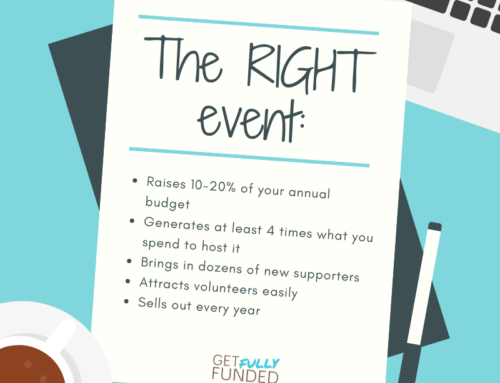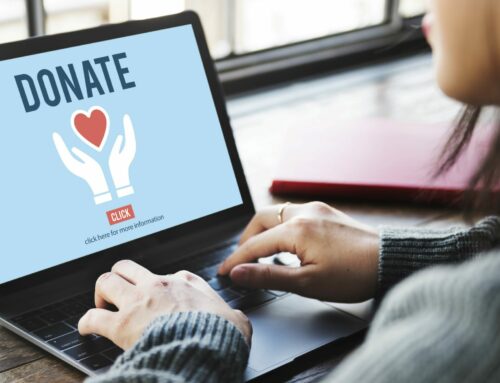
It’s simple really: the more sponsors you have, the more money you’ll net.
You’ll also gain credibility as you promote your event because the names of the businesses supporting you brings validity.
Having sponsors means the difference in an event that generates mediocre results and one that blows past your goals.
Unfortunately, most small nonprofits aren’t good at getting sponsors. They usually:
- Don’t have a well-thought-out sponsor invitation.
- Don’t start early enough to seek out sponsors.
- Don’t approach the right businesses.
The good news is that it’s all fixable.
ANY small nonprofit can build up sponsors for their event.
It might take a little time and a lot of effort, but it’s doable.
Let’s explore what makes a good sponsor and how to find them.
What is a Corporate Sponsor?
Before we go much further, let’s be clear about what a corporate sponsor is.
A sponsor for a fundraising event:
- Is typically a business or corporation giving money in exchange for publicity and good will.
- Gets their name and/or logo on event materials and signage.
- Pays for their sponsorship out of their marketing budget, philanthropy budget, or general profit of the business.

Sometimes, top sponsors are businesses owned by a nonprofit’s major donor, Board member, or someone else who is passionate about the organization’s mission.
From the business’ point of view, the fundraising event they’re considering sponsoring needs to be one that gets them in front of their target audience or at least gets them publicity or awareness that will support their sales.
Who makes a good corporate sponsor? Usually it’s a company with
- A good brand and recognition in the community
- Interest in supporting the community
- A desire to support your nonprofit
The best sponsors will not only give you money but will be bought into the success of the event.
They’ll help you promote the event, show up to fill their seats, and genuinely enjoy the event.
3 Must-Haves for Recruiting Corporate Sponsors
Finding sponsors requires a little art and a little science.
There are some definite “how to” steps you can follow, but success in getting corporate sponsors is about uncovering the specific company’s needs, interests, and expectations from their sponsor experience.
What do they want? What will help them reach their goals?
Keep your donor radar on as you talk with sponsor prospects to find out what’s most important to them.
You can tweak your sponsor invitation on the fly, if needed, to make it best fit the company. Just be sure you can deliver on anything you promise!
Before you approach anyone about a sponsorship, put a few things in place. Doing so will make you appear organized, which builds trust with your prospects.
These are:
- Sponsor packet or invitation detailing levels and benefits. This document, whether shared in print or electronic form, needs to look polished and be easy to glance through. It’s worth spending extra time and money to get the copy and design right. How it looks will have a big impact on the potential sponsor’s impression of you and your event.
- Event Committee members willing to go after sponsors. You won’t be able to get all the sponsors you need on your own. Many nonprofits expect their Board members to help get sponsors, and while some can, most won’t — which can leave you frustrated and doing most of the heavy lifting yourself. Instead of depending on your Board, create an event committee whose sole purpose is planning and executing the fundraising event. Recruit people for the committee who have business connections in the community, and most importantly, are WILLING to ask their contacts for a sponsorship for the event. This relationship is critical in getting a “Yes.”
- Acknowledgement plan for sponsors. Be ready with an immediate thank-you letter when businesses commit to sponsoring. Then, have a process to gather their logo and other info you need from them, and circle back to them after the event to thank them again and let them know how much was raised.
Once you have your materials and event committee ready, it’s time to make a list of sponsor prospects.
How to Find Corporate Sponsors
Biggest piece of advice: Don’t get a list from the local chamber or business association and send everyone a letter asking for a sponsorship.
I promise, it doesn’t work.
Why? Because there’s no relationship, and the business has no idea who you are or if you’re legit.
Instead, try these strategies:
1. Gather a list of prospects (with contact info) from last year’s event. This seems like a DUH, but I’m stunned at the number of nonprofits who don’t do this, so I’m including it in my recommendations. If you gave last year’s sponsors a good experience, it should be easy to renew them and maybe even upgrade them.
2. Have your event committee members make a list of businesses they have connections with. Personal contacts are CRITICAL in securing sponsorships.
3. Ask your staff, volunteers, and Board who they know at local businesses. You may have to jog their memory to help them remember that they know the manager at their dry cleaners or their cousin is the HR manager at the local plant or that their kids play soccer with the children of the owner of the big advertising company in town. A “sphere of influence” exercise can be really helpful here.

5. Look through your payables for sponsor prospects. Who are you spending money with? Consider all vendors as sponsor prospects. Reach out to them and remind them how much money you spend with them during the year and ask them to support your event in return.
6. Look around the community for companies that have a mission that’s in alignment with yours. Then, ask around to see if anyone knows anyone on the inside. Remember, a connection is key to getting the sponsor.
Tips for Getting New Corporate Sponsors
Corporate sponsors can quickly increase the total revenue generated by your fundraising event.
Not every company is a good sponsor prospect, and strategically, choosing sponsor prospects based on connections you have makes your chances of success increase dramatically.
Get your materials ready and go after prospects that have a connection with your nonprofit or an interest in your mission.
Give them a great experience this year, and they’ll come back again and again to sponsor.
All those sponsorship dollars increase your net results from your fundraising event, which helps you change more lives.
And that’s what we’re here for!


 Be clear what you’re asking for. There’s a difference in asking for a grant and a sponsorship. These two methods of funding typically have different goals and come from different places. Corporate foundations usually don’t give sponsorship money for an event. Instead, they like to fund projects or programs through grants. Sponsorships usually come from a companies’ marketing budgets and aren’t really philanthropy because they’re meant to draw attention to the business and their brand, ultimately increasing customer revenue.
Be clear what you’re asking for. There’s a difference in asking for a grant and a sponsorship. These two methods of funding typically have different goals and come from different places. Corporate foundations usually don’t give sponsorship money for an event. Instead, they like to fund projects or programs through grants. Sponsorships usually come from a companies’ marketing budgets and aren’t really philanthropy because they’re meant to draw attention to the business and their brand, ultimately increasing customer revenue.




Hello interested in more information about this to help support my Foundation
It’s great that you mentioned how corporate sponsorships consider if their brand can get across to their target audience or gain publicity before agreeing to sponsor an event. I’m an administrative staff of an elementary school, and we need sponsors for our month-long reading program later this year. We’ll have to look into where we can get trusted corporate sponsorships that can help support the event.
Absolutely! You’re thinking about it right – who is most likely to want to reach parents of elementary school kids? What businesses have missions that align with reading? Brainstorm some ideas then have some conversations with prospects. I bet you’ll find some sponsors.